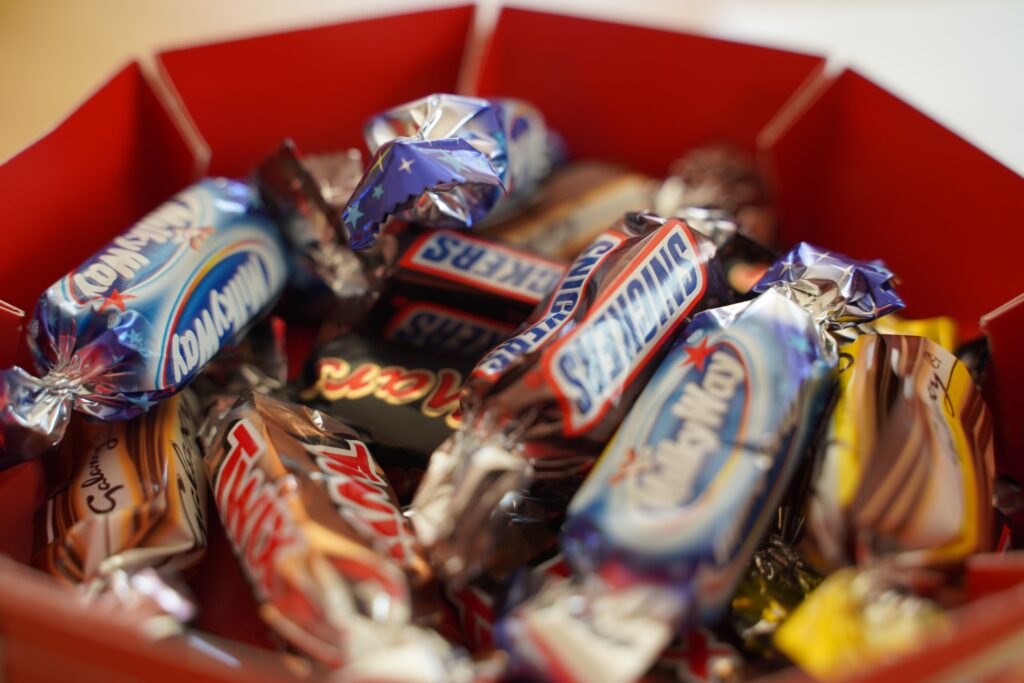According to the National Confectioners Association (NCA), 93% of Americans plan to celebrate the 2022 Halloween season. What’s more, the NCA projects an increase in sales of candy and chocolate by 5%.
And while there’s no reason to feel guilty about indulging in a Snickers bar (or a few), there is one problem when it comes to candy: candy wrappers, which contribute to our world’s plastic pollution problem.
However, thanks in part to biotechnology, we can spend more time worrying about witches and werewolves rather than our waste – here’s how.
From recycled plastic to biobased plastic
Mars Incorporated – the company that produces Halloween candy favorites including Snickers, Twix, Milky Way, M&Ms, Starburst, and Skittles – has launched sustainable candy packaging for many products, using recycled plastic and biobased plastic.
Mars recently launched new “club jars” that contain 15% recycled plastic. The new packaging is made in collaboration with Berry Global, and it is replacing around 300 tons of plastic per year.
According to the company, the new club jars are produced “using a single-pellet, food-grade resin to assure a clean, consistent packaging material sourced from mechanical recycling.”
Additionally, Mars reduced the weight of the two larger jars by 10 grams per jar. While this might seem like a small tweak, it affects the environment on a large scale, by saving 374 metric tons of carbon dioxide each year.
Last year, Mars also announced a partnership with Biotechnology Innovation Organization (BIO) member Danimer Scientific, which will produce wrappers for Skittles made out of biopolymer material that has the same look and feel as plastic but is fully biodegradable.
Danimer Scientific’s Nodax® polyhydroxyalkanoate (PHA) “is produced through natural fermentation processes using plant oils such as soy and canola and biodegrades in both soil and marine environments,” said the companies.
The product is made using soy and canola oils and goes through a natural fermentation process.
“The impact of plastic on nature is one of the major sustainability challenges of our generation. There are no simple solutions and transformational innovation is necessary, we have to think and act differently,” said Alastair Child, Mars Wrigley VP of Global Sustainability. “Collaborating with Danimer to advance this breakthrough technology represents a major step to creating positive societal impact and better environmental outcomes across the full lifecycle of small, flexible packaging.”
Mars has vowed to achieve net-zero emissions (Scope 3 included) in their whole value chain by 2050, which they will achieve with tactics including addressing deforestation and using renewable energy in their supply chains and operations. This pledge is supported by their short-term goal of reducing emissions by 27% by 2025.
So far, Mars seems to be on the right track, having reached a 6.1% reduction in emissions.
Responsibly-sourced cocoa
In addition to packaging, biotech is making our chocolate more sustainable, too – and ensuring we can enjoy the sweet treat for generations to come.
On the other side of the pond, the Mars Wrigley Europe arm revealed that as of 2023, 100% of the cocoa purchased for use in all of their factories across the continent will be responsibly sourced, per a press release.
The company revealed this as part of the effort to cut child labor, help the farmers working on cocoa farms have better conditions, and help the environment heal by reducing deforestation.
Mondelez – which manufactures treats including Cadbury and Sour Patch Kids – likewise announced it will in invest $600 million in sustainable cocoa sourcing before 2030, which would, in turn, reduce child labor in the African nations where a lot of cocoa is produced.
Biotech can improve cocoa
Due to the very few places where the climate is favorable for growing cocoa trees, as well as devastating diseases and fungi that occur in these conditions, scientists have long sought a solution to ensure future generations can enjoy cocoa and chocolate, according to Innovature.
The advancement in technology and development of the CRISPR-Cas9 innovation has helped the process of genome sequencing that might lead to cacao trees that will be resistant to certain diseases and fungi, and bring more yields for farmers.




